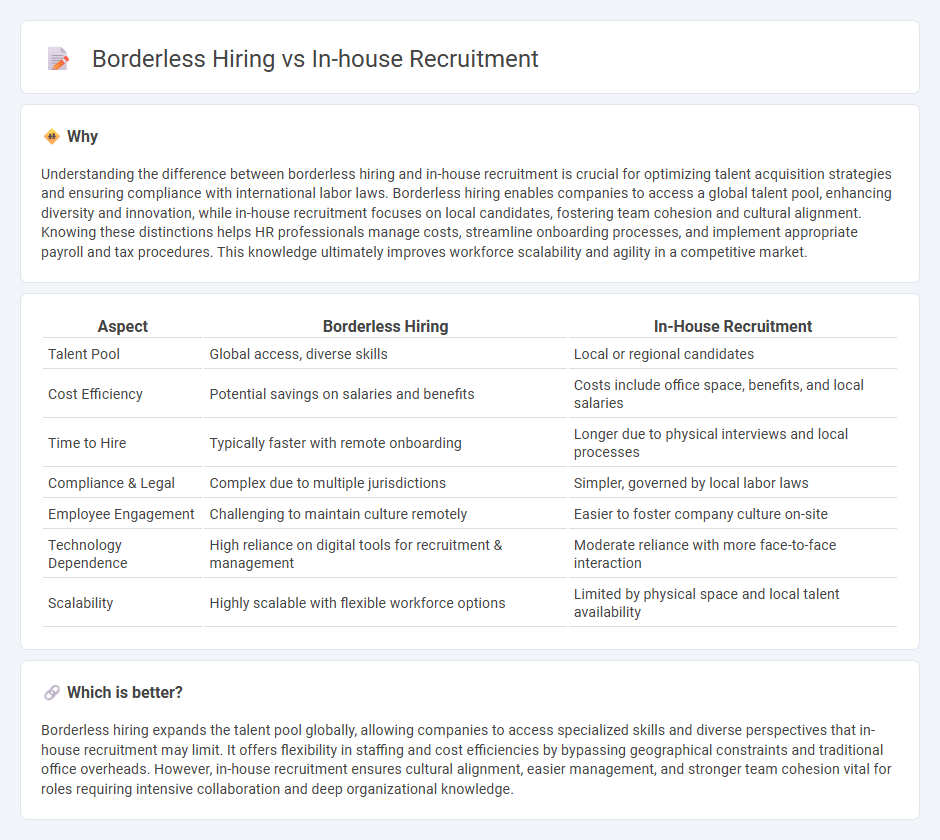
Borderless hiring leverages global talent pools, enabling companies to access diverse skills without geographic constraints, while in-house recruitment focuses on sourcing candidates locally to align closely with company culture and immediate team integration. Embracing borderless recruitment can reduce hiring costs and increase workforce flexibility, whereas in-house recruitment often offers stronger control over candidate evaluation and onboarding processes. Discover more about optimizing your HR strategy by comparing these recruitment models.
Why it is important
Understanding the difference between borderless hiring and in-house recruitment is crucial for optimizing talent acquisition strategies and ensuring compliance with international labor laws. Borderless hiring enables companies to access a global talent pool, enhancing diversity and innovation, while in-house recruitment focuses on local candidates, fostering team cohesion and cultural alignment. Knowing these distinctions helps HR professionals manage costs, streamline onboarding processes, and implement appropriate payroll and tax procedures. This knowledge ultimately improves workforce scalability and agility in a competitive market.
Comparison Table
| Aspect | Borderless Hiring | In-House Recruitment |
|---|---|---|
| Talent Pool | Global access, diverse skills | Local or regional candidates |
| Cost Efficiency | Potential savings on salaries and benefits | Costs include office space, benefits, and local salaries |
| Time to Hire | Typically faster with remote onboarding | Longer due to physical interviews and local processes |
| Compliance & Legal | Complex due to multiple jurisdictions | Simpler, governed by local labor laws |
| Employee Engagement | Challenging to maintain culture remotely | Easier to foster company culture on-site |
| Technology Dependence | High reliance on digital tools for recruitment & management | Moderate reliance with more face-to-face interaction |
| Scalability | Highly scalable with flexible workforce options | Limited by physical space and local talent availability |
Which is better?
Borderless hiring expands the talent pool globally, allowing companies to access specialized skills and diverse perspectives that in-house recruitment may limit. It offers flexibility in staffing and cost efficiencies by bypassing geographical constraints and traditional office overheads. However, in-house recruitment ensures cultural alignment, easier management, and stronger team cohesion vital for roles requiring intensive collaboration and deep organizational knowledge.
Connection
Borderless hiring expands talent acquisition beyond geographic constraints, enabling access to a diverse, global workforce. In-house recruitment leverages this approach by directly managing candidate selection, ensuring cultural fit and organizational alignment. Together, they optimize hiring efficiency and enhance workforce diversity, driving competitive advantage in Human Resources.
Key Terms
Talent Pool
In-house recruitment leverages a localized talent pool, allowing companies to develop strong connections with candidates who deeply understand the company culture and regional market demands. Borderless hiring expands the talent pool globally, offering access to diverse skill sets and innovation that may not be available locally, especially in tech, healthcare, and creative industries. Explore the benefits and challenges of each approach to determine the optimal talent acquisition strategy for your business needs.
Compliance
In-house recruitment ensures tight control over compliance with local labor laws, data protection regulations, and employment standards through direct management of the hiring process. Borderless hiring introduces complexities in compliance due to varying international regulations, tax obligations, and cross-border employment laws, demanding specialized expertise or third-party solutions. Explore the nuances of compliance challenges in both strategies to optimize your global talent acquisition.
Cost Efficiency
In-house recruitment often entails fixed overhead costs such as salaries, benefits, and office space, which can drive up expenses, especially for scaling teams. Borderless hiring leverages global talent pools, reducing costs through variable expenses and access to competitive salary markets without geographical constraints. Explore how businesses optimize recruitment budgets by comparing in-house versus borderless hiring strategies.
Source and External Links
What Is An In-house Recruiter? - Full Scale - In-house recruitment is the process where companies use their own HR staff to recruit, screen, and hire employees, with in-house recruiters managing the full hiring lifecycle from job posting to offer negotiation within their organization.
In-house recruitment team structure: The blueprint for hiring success - An in-house recruitment team is part of the organization focused solely on hiring needs, responsible for talent identification, employer branding, internal mobility, and recruitment strategy development.
In-house vs agency recruitment: The pros & cons of... - Beacon Hill - In-house recruiters are internal HR members who work closely with departments to identify hiring needs, define roles, and hire candidates as company employees, typically paid a salary without commission.
 dowidth.com
dowidth.com